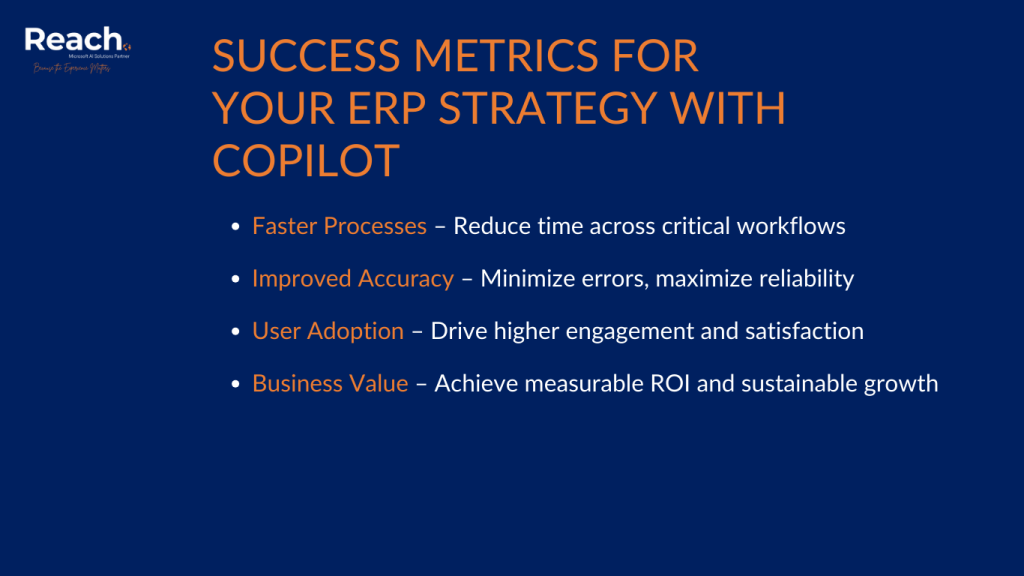The integration of AI into enterprise software isn’t just another technology trend—it’s fundamentally reshaping how organizations operate. Microsoft’s Copilot represents a paradigm shift in how businesses interact with their ERP strategy, moving from traditional point-and-click interfaces to conversational, intelligent assistance that understands context and anticipates needs.
For organizations evaluating or currently using ERP solutions, understanding Copilot’s implications isn’t optional. It’s essential for maintaining competitive advantage and ensuring your technology investments align with the future of business operations.
Understanding Microsoft Copilot in the ERP Context
Microsoft Copilot extends far beyond simple automation or chatbot functionality. Within ERP environments, particularly in Microsoft Dynamics 365, Copilot acts as an intelligent layer that interprets natural language requests, analyzes complex datasets, and executes multi-step processes that traditionally required specialized knowledge and significant manual effort.
Real-World Application Example
Consider a procurement manager who needs to analyze supplier performance across multiple dimensions while considering seasonal variations and currency fluctuations.
Traditional Approach:
- Extract data from various modules manually
- Manipulate data in Excel
- Create reports through multiple tools
- Time required: Hours or days
With Copilot:
- Simply ask: “Show me our top suppliers by reliability score, adjusted for seasonal delivery patterns, with cost trends over the past 18 months”
- Receive instant, actionable insights
- Time required: Seconds
Key Capabilities in ERP Environments
- Intelligent Process Automation: Draft purchase orders based on historical patterns and current context
- Predictive Analytics: Suggest optimal inventory levels by analyzing demand signals and market trends
- Risk Identification: Identify potential supply chain disruptions by correlating multiple data sources
- Continuous Learning: Adapt to organizational patterns, becoming more valuable over time
- Cross-Module Integration: Access and synthesize data across all ERP modules seamlessly
Strategic Implications for Your Organization
1. Redefining ROI Calculations
The introduction of Copilot necessitates a fundamental reconsideration of how we measure ERP value:
- Traditional Metrics: Process automation, cost reduction, efficiency gains
- New Metrics: Decision speed, insight quality, innovation capability, competitive differentiation
- Value Shift: From pure automation to intelligence augmentation
2. Data Strategy Becomes Mission-Critical
Why Data Quality Matters More Than Ever:
- Copilot’s effectiveness directly correlates with data quality and completeness
- Siloed data structures limit AI capabilities
- Inconsistent data governance prevents full value realization
- Clean, integrated data becomes a competitive advantage
Required Investments:
- Comprehensive data cleansing initiatives
- Standardization across all systems
- Robust governance frameworks
- Real-time data integration capabilities
3. Competitive Landscape Transformation
Organizations with Copilot-enabled ERPs will:
- Identify market opportunities 3-5x faster
- Respond to disruptions in real-time vs. days
- Optimize operations with unprecedented precision
- Make data-driven decisions at every level
This creates two distinct categories:
- AI-enabled enterprises with enhanced capabilities
- Traditional operators falling progressively behind
4. Evolving Workforce Requirements
Skills Declining in Importance:
- Manual data entry and manipulation
- Technical ERP navigation expertise
- Report generation and formatting
Skills Increasing in Value:
- Strategic thinking and analysis
- Prompt engineering and AI communication
- Data interpretation and validation
- Cross-functional business understanding

Implementation Considerations
Technical Architecture Assessment
Cloud vs. On-Premises Considerations:
- Cloud-Based Systems
- Faster Copilot integration
- Automatic updates and improvements
- Lower technical barriers
- On-Premises Systems
- Require migration planning
- Additional infrastructure investments
- Longer implementation timelines
Legacy Customization Analysis
Critical Questions to Address:
- Which customizations become obsolete with Copilot’s natural language capabilities?
- Which customizations might block Copilot’s data access?
- How can we preserve critical custom functionality while enabling AI?
- What’s the cost-benefit of maintaining vs. retiring customizations?
Change Management Strategy
Key Success Factors:
- Education Programs
- Demonstrate enhancement vs. replacement narrative
- Provide hands-on training opportunities
- Share success stories regularly
- Champion Networks
- Identify early adopters in each department
- Empower them to showcase practical wins
- Build peer-to-peer learning systems
- Phased Rollout Approach
- Start with high-impact, low-risk areas
- Build confidence through quick wins
- Expand based on lessons learned
Security and Compliance Framework
Essential Considerations:
- Data Governance
- Define what data Copilot can access
- Establish user permission hierarchies
- Create audit trails for AI-assisted decisions
- Compliance Requirements
- Document AI decision-making processes
- Ensure regulatory standard adherence
- Maintain human oversight mechanisms
- Risk Management
- Validate AI recommendations before implementation
- Establish override protocols
- Monitor for bias and errors
Preparing Your Organization for the Copilot Era
Phase 1: Assessment and Planning (Months 1-3)
Immediate Actions:
- Conduct comprehensive ERP landscape assessment
- Document existing processes and pain points
- Evaluate current data quality and structure
- Identify priority areas for Copilot implementation
- Build business case with revised ROI metrics
Phase 2: Foundation Building (Months 3-6)
Data Preparation:
- Consolidate disparate data sources
- Standardize data formats and definitions
- Implement data quality monitoring
- Establish governance frameworks
- Create master data management strategy
Organizational Readiness:
- Develop AI literacy training programs
- Teach prompt engineering basics
- Create change management plan
- Identify and train champions
- Communicate vision and benefits
Phase 3: Pilot Implementation (Months 6-9)
Recommended Pilot Areas:
- Supply chain optimization
- Financial forecasting and analysis
- Customer service enhancement
- Inventory management
- Procurement processes

Success Metrics:
- Time reduction in key processes
- Accuracy improvements
- User adoption rates
- Business value generated
Phase 4: Scale and Optimize (Months 9+)
Expansion Strategy:
- Roll out to additional departments
- Integrate more complex use cases
- Refine based on learnings
- Measure and communicate ROI
- Plan for continuous improvement
Best Practices for Success
Do’s:
- Start data preparation immediately
- Invest heavily in change management
- Choose pilot projects with measurable impact
- Build flexibility into implementation plans
- Focus on user adoption and satisfaction
- Document and share success stories
- Maintain human oversight and validation
Don’ts:
- Treat Copilot as just another feature
- Underestimate data quality importance
- Rush implementation without preparation
- Ignore employee concerns about AI
- Neglect security and compliance requirements
- Assume immediate ROI without investment
- Implement without clear success metrics
The Path Forward
Microsoft Copilot represents more than an incremental improvement to ERP systems—it’s a fundamental reimagining of how humans and enterprise software interact. Organizations that recognize this shift and adapt their strategies accordingly will find themselves with significant competitive advantages.
Key Takeaways:
- Copilot is transformative, not incremental – Plan accordingly
- Data quality determines success – Invest in your data foundation now
- Change management is critical – Focus on people as much as technology
- Early movers gain advantage – Start preparation immediately
- Flexibility is essential – Build adaptive strategies for evolving capabilities
The question isn’t whether to integrate Copilot into your ERP strategy, but how quickly and effectively you can do so while maintaining operational stability and driving meaningful business value. As you evaluate your ERP strategy in light of Copilot’s capabilities, remember that this technology will continue evolving rapidly.
The organizations that thrive will be those that view Copilot not as a destination but as a powerful companion on the journey toward truly intelligent enterprise operations. Start your preparation today and contact us—your future competitiveness depends on it.

